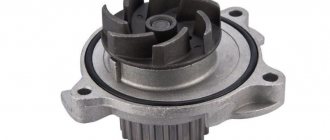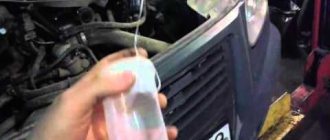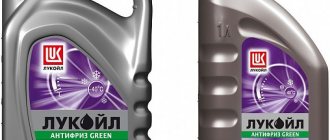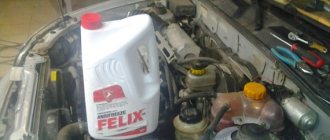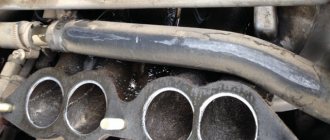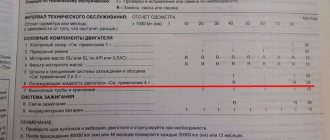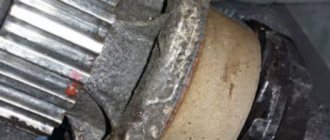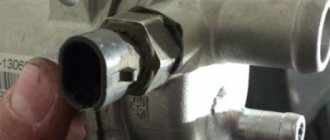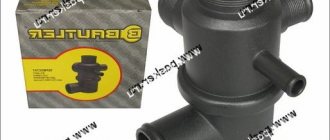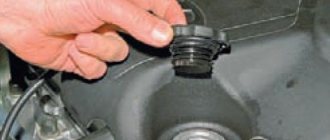About colored antifreezes
The product itself is colorless. The colored liquid is made from the dyes included in the composition. It is due to these substances that the coolant acquires one color or another. Antifreezes are colored so that the car enthusiast can distinguish the products from ordinary water. The basis of any coolant is ethylene glycol. It is dangerous and poisonous to humans. In addition, colored antifreeze helps identify leaks in the system. And finally, the shades indicate some of the properties and characteristics of the liquid.
Where liquids are used and terms of use
Solutions are used in cooling systems of internal combustion engines installed on tracked or wheeled vehicles, as well as on aircraft.
Recommendations for the type and composition of the liquid are indicated by the manufacturer in the technical documentation.
The service life depends on the degree of heating of the material; under standard conditions of use, replacement is made after 2-3 years for silicate compositions and after 5 years for carbon or lobride compositions. Information about the frequency of maintenance is indicated on the label or in the instructions for the car.
G12: red and its shades
G12 coolants are traditionally produced in red and its shades. This is anything from pink to maroon. Experts classify this mixture as the carboxylate type. The composition contains organic additives that have a selective effect. The liquid creates a durable protective layer only on those surfaces where there are already pockets of corrosion. These antifreezes were developed in the 90s. These fluids are excellent for working with high-speed and hot engines. This composition serves no more than 5 years.
This composition was developed in 2008. These fluids were widely used by the Peugeot-Citroen group in new models. As for the color, it is also traditionally red. These hybrids are similar to G11. But it contains fewer chemical reagents. Organic matter here is about 50 percent.
Key differences between coolants
The main differences between antifreeze compounds for cooling systems of automobile engines from water:
- They do not form a thick film on metal surfaces, which impairs heat transfer, and provide improved removal of excess heat from the parts of the power unit.
- They can withstand air temperature drops down to -40°C, and during crystallization they retain their original volume (expansion does not exceed 1.5%).
- They have increased chemical stability when overheated. The additives included in the composition do not form sediment that contaminates the sensitive elements of the sensors.
- The additives introduced into the composition reduce cavitation processes and extend the service life of the pump and sleeves (with a wet heat removal system), and also do not have a negative effect on rubber or silicone pipelines or seals.
- They have an extended service life. For materials on hybrid or lobrid bases, the replacement interval is 5 years or more.
So what about the color
There are several opinions on this matter, but the truth has not yet been revealed. Some information does appear in the public domain. At first glance, there are few differences between colored liquids - these are additives. But a large army of car enthusiasts forget that each series of cars uses different types of radiators and different engines. If the radiator is copper, then it is worth remembering what color the antifreeze is and what the car manufacturers recommend. For such heat exchangers, it is recommended to use the red version. If the radiator is aluminum, then green will do.
What to choose
Often, novice car owners try to purchase coolant based only on its color. This is not entirely correct. It is best to focus on classes. This is the only way to acquire true, proven quality. And if you focus on which antifreeze is better in color, you can buy regular antifreeze instead of the G11 product under the guise of a quality product. And again, you need to look at the class of coolant for a particular car, as well as the material from which the radiator is made. Only after this do we pay attention to the colors of the liquid. As for a quality product, you can pay attention to Sintek products. Here you can choose by color. And for those who don’t know what color Sintek antifreeze comes in, let’s say - all the colors described above.
As you know, antifreeze (coolants) are necessary for the cooling system to operate any vehicle. They perform the function of cooling the engine and help prevent it from overheating. Today we will tell you how green antifreeze differs from Tosol and what are the characteristics of these liquids.
If you know the difference between liquids of different colors, but are not familiar with what technical characteristics correspond to green refrigerants, then we will tell you about it. One way or another, green antifreeze is a type of coolant, and this concentrate has recently become increasingly popular among domestic motorists.
Filling coolant into the expansion tank
Proper car service
During operation of the machine, it will always be necessary to replace the coolant. It is recommended to perform such work every 2-3 years or after 50-70 thousand kilometers. Experts recommend performing a complete fluid change, when the antifreeze is drained not only from the expansion tank and radiator, but also from the jacket in the engine. Antifreeze is poured into the radiator and expansion tank, the system is pumped and ventilated.
Replacing coolant in most modern cars is not difficult, so every driver can do this job. The car owner only needs to know how antifreeze stands for, and depending on this, make the right choice. It is necessary to use only high-quality antifreeze , and when the first problems appear in the operation of the cooling system, a complete engine diagnostics should be performed, which will prevent engine overheating.
Characteristics and Features
G11 standard refrigerants are silicate antifreezes. As you know, any coolant (hereinafter referred to as coolant) has no color and is produced exclusively colorless. Refrigerants are “awarded” directly by color by the manufacturer, but all liquids have their own standard, which can match the color.
In particular, G11 standard coolants can be painted in blue, yellow, orange and green. It should be noted that green is one of the most popular and common colors. “Antifreeze” is a domestic analogue of refrigerant manufactured according to the G11 standard. This liquid can interact with all surfaces of the system, simultaneously covering all elements and parts with a protective layer. The service life of green coolant, as a rule, does not exceed three years. However, here too everything depends on the manufacturer - it is impossible to accurately determine the service life of the concentrate.
Red and green coolant of different classes - G11 and G12 - from one manufacturer
Compound
The G11 standard coolant can be based on either ethylene glycol or promylene glycol. Here everything also depends on the manufacturer. As a rule, such coolants are considered the most budget-friendly, and they contain a minimal package of additives. Actually, green color was assigned to this class. By the way, the original purpose of the colors was to distinguish between different classes of refrigerants.
In addition, this coolant can be used as a working fluid in other heat exchange systems that are used at low and medium temperatures.
It should also be noted that this coolant is intended for use in cooling systems of engines that operate on the principle of internal combustion of gasoline. As for the operating temperature range, green coolants are no different from traditional antifreezes: from “-40” to “+50” degrees of ambient temperature.
Drained coolant from the system
Additives
Each individual coolant manufacturer can and does use its own additives. Moreover, in the line of one coolant manufacturer, the number and composition of additives used may differ. And green antifreeze can also have different properties, depending on the additive package used. In particular, additives can be:
- anti-foam (preventing the formation of foam in the cooling system and expansion tank);
- anti-corrosion (preventing corrosion on metal elements of the cooling system);
- preventing negative effects on the rubber components of the cooling system.
Composition and purpose
First, you need to understand that the liquids in question are intended to stabilize the operation, or rather cooling, of power plants and motors that operate at subzero temperatures.
They are designed to replace the conventional water used in the past, which has a significantly lower freezing point and expansion rate. Antifreeze is a term that unites all coolants for cars, regardless of composition, components, concentration and place of production.
The basis for them is ethylene glycol or propylene glycol, diluted with water with the addition of additives. The latter are designed to protect mechanisms from corrosion and prevent the formation of condensation, steam or foam.
Among other things, antifreezes are tinted. A change in the original color is a signal to replace a liquid that has lost its properties and is unsuitable for further use.
Today, “anti-freeze” agents are divided into several types, depending on the friction additives included in the composition.
- OAT or carboxylate . The abbreviation stands for: Organic Acid Technology, which is explained by the presence of organic acid inhibitors that prevent corrosion and cavitation. G-12s serve for about five years.
- Hybrid or hybrid . Contains both organic and inorganic (silicates, nitrites or phosphates) inhibitors. The full name of this type is Hybrid Acid Organic Technology. G-11 retains its properties from three to five years.
- Lobrid or lobrid . The newest and most technologically advanced composition, combining an organic base and mineral inhibitors. Experts called the technology SOAT coolants. Formula G-13 is still being improved.
- Traditional or traditional . Anti-corrosion inhibitors of this type are created from inorganic compounds and/or combinations thereof. This type is commonly called Inorganic Acid Technology (IAT). The effectiveness period does not exceed two years.
Traditional compositions have a short service life, reduce heat transfer and lose their properties at temperatures exceeding +105 °C, therefore they are considered obsolete and are not actually used. In this video, you can view a comparison of coolants. Enjoy watching!
Antifreeze is an antifreeze belonging to the traditional group, consisting of water, ethylene glycol and inorganic inhibitors. The substance and its modifications acquired their name thanks to the abbreviation and trademark “TOSOL”, which is interpreted only as “technology of organic synthesis of a separate laboratory”.
Historical excursion
Initially, water was poured into vehicle radiators to cool the engine. To prevent it from freezing in the cold and tearing the parts of the system, they began to dilute it with ethylene glycol.
This solution turned out to be successful, since when the temperature dropped, the composition turned into a viscous liquid that could not harm cast-iron motors and brass radiators. This is how antifreeze was invented, which literally means “against frost.”
With the advent of modern materials and technologies, the problem of protection against corrosion caused by the aggressiveness of the coolant composition has arisen. The GosNIIOKhT Institute solved the problem by using inorganic additives that protect metal surfaces and are resistant to ethylene glycol.
The new product was named after the first letters of the full name of the department involved in the development. “Tosol” is an antifreeze that was produced in the USSR and had no competitors, since imported goods were rare in the country.
Therefore, the name of the product rather quickly turned from a proper name into a common noun - the general name for “anti-freeze” on the Soviet market.
“Tosol” - antifreeze from the USSR
Thus was born the myth about the significant differences between antifreeze and antifreeze. However, without fire there is no smoke, and there is still a difference.
The Tosol product was initially developed exclusively for domestic VAZ engines, and therefore was recommended for use only for them. This in no way indicates poor quality or low performance, however, the stereotype that this elite liquid is only suitable for Lada cars is firmly entrenched in the minds of ordinary people.
Over time, concepts have changed. “Zhiguli” became synonymous with “clumsy” work, and “Tosol” was transferred from the elite category to low-grade chemistry for “bad” cars.
This is despite the fact that it was in no way inferior to foreign inorganic analogues. Serious differences with representatives of other groups (G-11, G-12 and G-13), their additives, compositions and colors are described above.
Today the Russian market offers “Tosol” of the following brands:
- A is a concentrate that requires preparation according to the instructions.
- A40 is a finished product that retains properties down to -40 °C.
- A65 is a grade effective down to -65 °C.
The average service life recommended by the manufacturer is three seasons or 60,000 km. mileage
Operational indicators.
Traditional antifreezes, including antifreeze, cover the metal with a half-micron protective film. This prevents corrosion processes, but at the same time, reduces heat transfer, and therefore increases fuel consumption and the wear rate of the power unit.
Also disadvantages are: loss of cooling capacity after 55-60 thousand km. mileage, precipitation and salts, maximum operating temperature 105 °C. Fluids of groups G-11/12/13 create a protective layer exclusively in areas susceptible to corrosion, so the rest of the engine area does not lose heat transfer.
In addition, this antifreeze retains its properties even after 250 thousand kilometers traveled by a passenger car. Organic compounds of additives do not leave residues, and the boiling point is significantly higher than 105 degrees.
Tuning a VAZ 2110 with your own hands. Read more on our website.
Here is information on how to choose a radar detector for your car.
You can learn how to adjust the valves of a VAZ 2109 from this article. We recommend reading!
Video “Which coolant is better to fill in your car?”
This video describes the criteria by which you should select a coolant for your vehicle.
Almost every car enthusiast knows that there is antifreeze in a car engine. Many people call it “antifreeze” or “coolant,” but all these concepts are the same thing. Any antifreeze is a liquid containing various additives. In the store you can see green, blue, red, orange antifreeze created for car engines. A reasonable question arises: what affects the color of antifreeze? Let's look into this, and also find out whether it is possible to mix antifreeze of different colors.
Characteristics of antifreeze a-40m
The first Soviet antifreeze was developed in 1971. It was intended for use in VAZ cars. Then they began to use it for other transport. A letter expression in the form of “A” means that the solution is intended only for vehicles. And the letter M indicates that the antifreeze is modernized.
The composition of antifreeze a 40 is of the highest quality. The main component of this solution is ethylene glycol alcohol. It also contains various anti-corrosion and anti-foam additives.
The main characteristics of antifreeze a-40 are:
- Withstands temperatures and does not freeze at -45 degrees.
- Boiling point Celsius 110 degrees.
- No foaming.
- Its chemical composition does not affect other vehicle systems.
- Has low density.
- It does not deteriorate or decompose during storage.
Is it possible to mix antifreeze of different colors?
Since the color of antifreeze is determined only by the dye, there may be an illusion that all antifreeze is the same. However, as we wrote above, coolants differ from each other, but not in color, but in other parameters. At a minimum, they are divided according to the composition of functional additives into 4 types:
- G11: Hybrid antifreezes, contain organic and inorganic inhibitors;
- G-12, G-12+: Carboxylate antifreezes, characterized by a service life of more than 5 years;
- G-12++, G-13: Contains mineral inhibitors;
- Traditional antifreeze: Considered obsolete, they are sometimes used by car manufacturers when first filling the coolant tank.
The canister in which the antifreeze is supplied always indicates what type it is. It is this parameter that you should look at first if you want to mix antifreeze of different colors.
However, even when mixing antifreeze of the same type, the old liquid can conflict with the new one, as a result of which their protective and cooling properties will decrease or disappear altogether. Even if you mix red G-12 antifreeze with antifreeze of the same color and type from another manufacturer, there are risks of conflicts between the liquids. That is why it is not recommended to mix antifreeze of different colors or the same color - it is better to completely change the coolant in the car so as not to doubt its properties.
If you need to add antifreeze, but you can’t find the same liquid on sale, all that remains is to select the most compatible options. There is a simple folk recipe that allows you to determine whether antifreezes of different colors or the same color are suitable for each other. To do this, coolants are poured into one container and an experiment is being conducted on them. For example, you can take a little antifreeze from a car and the same amount from a new canister. If their consistency does not change when mixing, then everything is fine. But if the mixed liquid becomes cloudy or a precipitate has formed, antifreeze cannot be used together.
Why does a motorist need to know this?
As a rule, motorists know what is in their cooling systems. But this is the case if we are talking about the permanent owner of the car. In fact, there can be a lot of reasons why a motorist wants to find out what exactly is poured into the expansion tank of his car. Eg:
- The vehicle was recently purchased - it would be logical to find out what refrigerant is in the system and when it was last changed.
- There are problems with the car's cooling system - the heater is not working well, the engine periodically boils. In some cases, these consequences may be caused by poor-quality consumable fluid. Then the motorist will be interested in knowing what consumables are in his car so that he never uses it in the future.
- The cooling system works great over time and overall there are no shortcomings. In this case, the driver will also be interested to know what is poured into the system - “Tosol” or antifreeze, so that in the future he can fill in this particular coolant.
Pink coolant in the expansion tank
